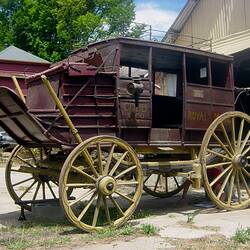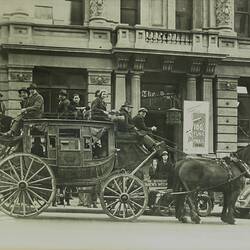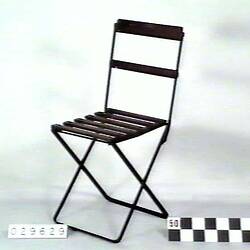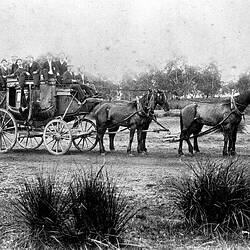Summary
'Cobb & Co' coach driver's leather money pouch or bag with shoulder strap.
The specific history of this particular driver's pouch is unknown; however, it was purchased by the vendor from a second-hand market at Maryborough. It was sold by a local resident who had found it amongst his late father's possessions following his father's death. It was probably used in Victoria and possibly in the Maryborough district, where by 1882 there were coach routes running from Ballarat to St Arnaud (via Lexton & Avoca), from Avoca to Ararat (later replaced by a railway in 1890), and from St Arnaud to Stawell, Rupanyup and Charlton.
The pouch provides an evocative example of the use of the 'Cobb & Co' branding that was retained almost universally by all Victorian coach operators from the 1860s until the end of the horse-drawn coach era around the First World War, even though the original partners had sold all their interests in the coaching business in 1856 and played no role in the subsequent expansion of coaching routes.
Physical Description
Semi-circular leather pouch with curved flap folding from back over top opening, closed with a leather strap and nickel? plated metal buckle. The pouch is double hand-stitched around the sides and bottom and has a long adjustable length shoulder strap is attached to the back. The ends of the shoulder strap pass through slits on either side of the rear face and are anchored with a single copper rivet at each end. The words "COBB" and "& CO" are tooled on either side of the closing strap on the front flap and the letters "T.G.E." or "T.G.F." (possibly a driver's initials) are scratched on the back of the pouch beside the strap top at the top left-hand corner. The strap on the front flap is attached through a slit in the flap by a copper rivet with a large nickel-plated domed head inside an circular nickel-plated metal ring. The strap is closed with a large flower-shaped nickel-plated buckle, attached by a leather tab riveted to the lower front face of the pouch.
Significance
This pouch is a rare example of a smaller artefact relating to the Victorian operations of the well-known "Cobb & Co" coaching enterprise, which had its origins during the Victorian goldrushes of the 1850s and reached its peak during the latter decades of the 19th century when a loosely associated group of transport operators working under the original "Cobb & Co" name were providing a vast network of passenger and mail coach services extending over thousands of miles throughout the eastern mainland states of Australia. By 1870, Cobb & Co coach owners were harnessing some 6,000 horses a day and covering 28,000 miles of road weekly conveying passengers, mail, gold & general parcels to and from country towns in Victoria, New South Wales and Queensland.
The pouch provides an insight into the day to day operations of a coach line and the multifaceted role of the coach driver. Leather shoulder pouches like these were used by coach drivers for carrying money for fares and freight collected on route and for holding copies way bills recording the details of consignments of goods and valuables.
Coach drivers held an important position in colonial Australian society. They provided a lifeline for isolated rural communities and when on the road had the sole responsibility for the safe passage of passengers, mails, parcels and valuables, including consignments of gold. Coach businesses depended for their reputation and survival on the skills, competence and accomplishments of their drivers. Initially the original Cobb & Co partnership, and many of their competitors, employed expatriate American drivers, with prior experience working for the great coaching lines of the United States, but in later decades locally born and trained Victorians took over the reins. Commensurate with their skills and responsibilities, drivers were amongst the best paid workers in rural Australia commanding up to £10 to £14 a week during the halcyon days of the goldrushes in the 1850s and 60s and even at the turn of the century when railways had taken over the busiest passenger routes, wages of £3 a week were still common. Many drivers served for years or even decades on the same route becoming popular figures with their regular passengers and residents along the route. Their exploits of outstanding horsemanship, daring or courage to ensure the mails got through in the face of bushfires, floods or accident and breakdowns on route were long talked about around the bars of bush pubs and roaring fires in homestead living rooms.
More Information
-
Collecting Areas
-
Acquisition Information
Purchase
-
Organisation Named
-
Place & Date Used
Cobb & Co, Central Highlands, Victoria, Australia, circa 1880-1915
-
Inscriptions
Text, tooled: COBB & CO.
-
Brand Names
-
Classification
-
Category
-
Discipline
-
Type of item
-
Object Measurements
230 mm (Width), 25 mm (Depth), 360 mm (Height)
-
Keywords
Coaching Services, Horsedrawn Vehicle Accessories, Horsedrawn Vehicles, Road Transport






